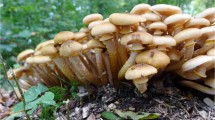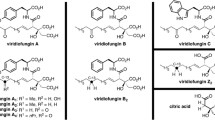Abstract
In this article, we describe the synthesis of a small library of short peptoids composed of four glycine residues and acylated with a fatty acid that showed a remarkable in vitro activity against two fungal plant pathogens. Their straightforward synthesis implied two consecutive Ugi reactions and can be efficiently extended to the construction of highly diverse libraries.
Similar content being viewed by others
References
Savary S, Teng PS, Willocquet L, Nutter FW Jr (2006) Quantification and modeling of crop losses: a review of purposes. Annu Rev Phytopathol 44: 89–112. doi:10.1146/annurev.phyto.44.070505.143342
Knight SC, Anthony VM, Brady AM, Greenland AJ, Heaney SP, Murray DC et al (1997) Rationale and perspectives on the development of fungicides. Annu Rev Phytopathol 35: 349–372. doi:10.1146/annurev.phyto.35.1.349
Brogden KA (2005) Antimicrobial peptides: pore formers or metabolic inhibitors in bacteria. Nat Rev Microbiol 3: 238–250. doi:10.1038/nrmicro1098
Marcos JF, Muñoz A, Pérez-Payá E, Misra S, López-García B (2008) Identification and rational design of novel antimicrobial peptides for plant protection. Annu Rev Phytopathol 46: 273–330. doi:10.1146/annurev.phyto.121307.094843
Straus SK, Hancock RE (2006) Mode of action of the new antibiotic for Gram-positive pathogens daptomycin: comparison with cationic antimicrobial peptides and lipopeptides. Biochim Biophys Acta 1758: 1215–1223. doi:10.1016/j.bbamem.2006.02.009
Makovitzki A, Avrahami D, Shai Y (2006) Ultrashort antibacterial and antifungal lipopeptides. Proc Natl Acad Sci USA 103: 15997–16002. doi:10.1073/pnas.0606129103
Makovitzki A, Viterbo A, Brotman Y, Chet I, Shai Y (2007) Inhibition of fungal and bacterial plant pathogens in vitro and in planta with ultrashort cationic lipopeptides. Appl Environ Microbiol 73: 6629–6636. doi:10.1128/AEM.01334-07
Zuckermann RN, Martin EJ, Spellmeyer DC, Stauber GB, Shoemaker KR, Kerr JM, Figliozzi GM, Goff DA, Siani MA, Simon RJ, Banville SC, Brown EG, Wang L, Richter LS, Moss WH (1994) Discovery of nanomolar ligands for 7-transmembrane G-Protein-coupled receptors from a diverse N-(substituted)glycine peptoid library. J Med Chem 37: 2678–2685. doi:10.1021/jm00043a007
Shin SBY, Yoo B, Todaro LJ, Kirshenbaum K (2007) Cyclic peptoids. J Am Chem Soc 129: 3218–3225. doi:10.1021/ja066960o
Masip I, Cortés N, Abad MJ, Guardiola M, Pérez-Payá E, Ferragut J, Ferrer-Montiel A, Messeguer A (2005) Design and synthesis of an optimized positional scanning library of peptoids: identification of novel multidrug resistance reversal agents. Bioorg Med Chem 13: 1923–1929. doi:10.1016/j.bmc.2005.01.024
Zuckermann RN, Kerr JM, Kent SBH, Moos WH (1992) Efficient method for the preparation of peptoids [oligo(N-substituted glycines)] by submonomer solid-phase synthesis. J Am Chem Soc 114: 10646–10647. doi:10.1021/ja00052a076
Chongsiriwatana NP, Miller TM, Wetzler M, Vakulenko S, Karlsson AJ, Palecek SP, Mobashery S, Barron AE (2011) Short alkylated peptoid mimics of antimicrobial lipopeptides. Antimicrob Agents Chemother 55: 417–420. doi:10.1128/AAC.01080-10
Dömling A (2006) Recent developments in isocyanide based multicomponent reactions in applied chemistry. Chem Rev 106: 17–89. doi:10.1021/cr0505728
Xu P, Zhang T, Wang W, Zou X, Zhang X, Fu Y (2003) Synthesis of PNA monomers and dimers by Ugi four-component reaction. Synthesis 8: 1171–1176. doi:10.1055/s-2003-39391
Rivera DG, Wessjohann LA (2006) Supramolecular compounds from multiple Ugi multicomponent macrocyclizations: peptoid-based cryptands, cages, and cryptophanes. J Am Chem Soc 128: 7122–7123. doi:10.1021/ja060720r
Vercillo OE, AndradeCKZ; Wessjohann LA (2008) Design and synthesis of cyclic RGD pentapeptoids by consecutive Ugi reactions. Org Lett 10: 205–208. doi:10.1021/ol702521g
Henze M, Kreye O, Brauch S, Nitsche C, Naumann K, Wessjohann LA, Westermann B (2010) Photoaffinity-labeled peptoids and depsipeptides by multicomponent reactions. Synthesis 17: 2997–3003. doi:10.1055/s-0030-1258182
Sui Q, Borchardt D, Rabenstein DL (2007) Kinetics and equilibria of cis/trans isomerization of backbone amide bonds in peptoids. J Am Chem Soc 129: 12042–12048. doi:10.1021/ja0740925
Heerma W, Verluis C, de Koster CG, Kruijtzer JAW, Zigrovic I, Liskamp RMJ (1996) Comparing mass spectrometric characteristics of peptides and peptoids. Rapid Commun Mass Spectrom 10: 459–464. doi:10.1002/(SICI)1097-0231(19960315)10:4<459::AID-RCM501>3.0.CO;2-J
Roepstorff P, Fohlman J (1984) Proposal for a common nomenclature for sequence ions in mass spectra of peptides. Biomed Mass Spectrom 11: 601. doi:10.1002/bms.1200111109
Jacob MR, Walker LA (2005) Natural products and antifungal drug discovery. In: Ernst EJ, Rogers PD (eds) Methods in molecular medicine vol 118: antifungal agents: methods and protocols 1st ed. Humana Press Inc, Totowa, NJ, pp 83–110
Hadacek F, Greger H (2000) Testing of antifungal natural products: methodologies, comparability and assay choice. Phytochem Anal 11: 137–147. doi:10.1002/(SICI)1099-1565(200005/06)11:3<137::AID-PCA514>3.0.CO;2-I
Makovitzki A, Viterbo A, Brotman Y, Chet I, Shai Y (2007) Inhibition of fungal and bacterial plant pathogens in vitro and in planta with ultrashort cationic lipopeptides. Appl Environ Microbiol 73: 6629–6636. doi:10.1128/AEM.01334-07
Shai Y (2002) Mode of action of membrane active antimicrobial peptides. Pept Sci 66: 236–248. doi:10.1002/bip.10260
Author information
Authors and Affiliations
Corresponding author
Electronic Supplementary Material
The Below is the Electronic Supplementary Material.
Rights and permissions
About this article
Cite this article
Galetti, M.D., Cirigliano, A.M., Cabrera, G.M. et al. Multicomponent synthesis of acylated short peptoids with antifungal activity against plant pathogens. Mol Divers 16, 113–119 (2012). https://doi.org/10.1007/s11030-011-9334-1
Received:
Accepted:
Published:
Issue Date:
DOI: https://doi.org/10.1007/s11030-011-9334-1




